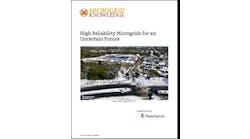On Eve of Microgrid Knowledge Conference, Microgrids Gain New Advocacy Clout with Merger
The two organizations announced their plans on the eve of a gathering in New York City of microgrid industry leaders, an event that is being organized by Microgrid Knowledge.
The merger folds MRC resources and technical and regulatory expertise into IDEA, a powerhouse advocacy organization with 2,100 members in 25 nations. The pairing is expected to strengthen information exchange, policy and technical advancement for microgrids, which Navigant Research forecasts will grow into a $20 billion industry by 2020.
“Microgrids are a growing segment of the energy industry and integral to our work at IDEA,” said Rob Thornton, IDEA president and CEO. “Today, we are witnessing a paradigm shift from remote central station power plants toward more localized, distributed generation for enhanced reliability, resiliency and energy efficiency, especially in cities, communities and campuses.”
He noted that IDEA members have been operating CHP/district energy microgrids for decades, long before the term ‘microgrid’ was even coined.
“IDEA and MRC have much in common in terms of membership and mission, and we share an objective to inform energy policy makers and regulators about the myriad benefits microgrids can deliver,” Thornton said.
He sees the merger deepening IDEA’s partnership with MRC and “integrating the regulatory and policy expertise of MRC with the practical, operational insights of over 2,100 IDEA members around the globe to accelerate microgrid deployment in North America.”
Tom Nyquist, executive director, engineering and campus energy for Princeton University and MRC chair, said that the MRC was formed principally “to advocate for a level playing field for microgrids in the energy regulatory arena.”
“Drawing from our operational experience, we have been informing regulators and advising policymakers, electric utilities and independent system operators on the range of benefits that microgrids can produce for end-users as well as the local and regional power grid,” Nyquist said.
Princeton University has a microgrid that is often cited as a model project. It kept power flowing to key parts of the campus during Superstorm Sandy although the surrounding community was in the dark.
“By operating in parallel with the traditional electricity grid, microgrids like the one at Princeton University can shift demand for expensive peak power and reduce strain on the local distribution network,” Nyquist said. “We are also able to optimize thermal energy and integrate intermittent renewable resources. On those occasions when severe weather interrupts regular utility service, the microgrid at Princeton can ‘island’ and isolate from the grid to provide our own continuous power, heating and cooling for critical research facilities on campus.”
Elisa Wood, chief editor of Microgrid Knowledge, described the pairing as timely.
“So much innovative energy technology is vying for the attention of regulators, policymakers, investors and customers. The industry needs to firmly establish its place at the table. Through this merger microgrids gain new advocacy clout and position,” she said as the Microgrid Knowledge conference, “New York and Beyond: Advancing Microgrids Nationally with Lessons Learned in New York” kicked off in Manhattan.
Microgrids are gaining attention because of their ability to keep the lights on even during disasters and power outages. But the early stage market still faces barriers to widespread implementation, such as conflicting regulations at federal, state, and local levels. Through the merger, IDEA and MRC plan to combine technical, regulatory and policy resources to educate and engage with federal and state energy regulatory and policy agencies, as well as utility business leaders and local governments.
IDEA joined MRC as a founding member in 2014, and all current MRC member companies are also IDEA members. Members of both organizations have common perspectives on the energy industry, making their official alliance a natural step.
ABOUT THE INTERNATIONAL DISTRICT ENERGY ASSOCIATION
The International District Energy Association (IDEA) is a nonprofit trade association founded in 1909 to facilitate the exchange of information among district energy professionals. IDEA works actively to foster the success of members as leaders in providing reliable, economical, efficient and environmentally sound district heating, district cooling and cogeneration (also known as combined heat and power or CHP) services. Today, IDEA has over 2,100 members in 25 nations and is governed by an all-volunteer Board of Directors.
ABOUT THE MICROGRID RESOURCES COALITION
The Microgrid Resources Coalition is a consortium of leading microgrid owners, operators, developers, suppliers and investors formed as an unincorporated nonprofit association under the laws of the District of Columbia. The purpose of the MRC is to advance microgrids as energy resources. The MRC promotes the widespread implementation of microgrids through advocacy for laws, regulations and tariffs that support their access to market, compensate them for their services, and provide a level playing field for their deployment and operations.
Track breaking news about the microgrid industry. Sign up for the free Microgrid Knowledge newsletter.








